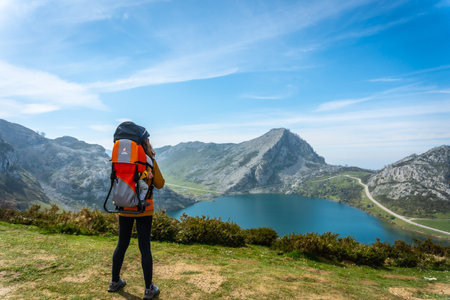1. Choosing the Perfect Backpacking Destination
Picking where to go is one of the most exciting parts of planning a multi-day backpacking trip in the US. The country is packed with famous routes and hidden gems, each offering something unique for every kind of hiker. To make sure your adventure matches your experience level and what you want to see, consider terrain, scenery, seasons, and trail length.
Well-Loved vs. Off-the-Beaten-Path Trails
| Trail Type | Examples | Why Choose? |
|---|---|---|
| Classic & Popular Trails | John Muir Trail (CA), Appalachian Trail (East Coast), Wonderland Trail (WA) | Marked trails, established campsites, stunning scenery, easy to plan logistics |
| Hidden Gems & Less-Traveled Paths | Teton Crest Trail (WY), Uinta Highline Trail (UT), Lost Coast Trail (CA) | More solitude, unique landscapes, less crowding, can require more navigation skills |
Consider Terrain & Scenery
The US has everything from high alpine mountains and wildflower meadows to deep forests and desert canyons. Think about what kind of scenery inspires you the most and what terrain fits your skill level. For example:
- Mountains: Try the Sierra Nevada or Colorado Rockies for challenging climbs and epic views.
- Deserts: Explore Utah’s red rock country or Arizona’s Superstition Wilderness for dramatic landscapes and fewer bugs.
- Coastal: Walk the Olympic Coast in Washington or the Lost Coast in California for ocean views and beach camping.
- Forests: Trek through the Smokies or Green Mountains for lush woods and classic American wildlife.
Seasonal Considerations
| Season | Best Regions/Trails | What to Expect |
|---|---|---|
| Spring (Mar-May) | PCT Southern California, Grand Canyon, Ozark Highlands Trail | Milder temps, snow melt in higher elevations, wildflowers blooming |
| Summer (Jun-Aug) | Sierra Nevada, Cascades, White Mountains, Rockies high country | Main hiking season in most mountain areas, longer daylight hours, possible afternoon storms in mountains |
| Fall (Sep-Nov) | Appalachian Trail sections (for fall colors), Arizona Trail, Pacific Northwest lowlands | Cooler temps, beautiful foliage, fewer crowds but shorter days |
| Winter (Dec-Feb) | Baja Peninsula, Florida Trail, lower elevation desert trails in CA/AZ/NM/TX | Mild weather in southern regions; avoid high elevation snow unless experienced in winter conditions! |
Match Trail Length to Your Adventure Level
- Weekend Warriors: 2-3 day trips are great for beginners or those with limited time. Look for loops or out-and-back trails around 15-30 miles total.
- Aspiring Thru-Hikers: Want a bigger challenge? Multi-week treks like sections of the Appalachian or Pacific Crest Trail let you test your endurance.
- Lifelong Adventurers: Dreaming big? Plan for iconic thru-hikes that last a month or more—just be sure you’re ready for the commitment!
Quick Tips for Picking Your Destination:
- Check permits: Some trails require advance reservations—these can fill up fast!
- Study maps & trip reports: Learn about water sources, campsites, trail conditions.
- Know your limits: Be honest about your fitness and backcountry skills.
- Aim for flexibility: Have backup plans in case of weather or trail closures.
No matter where you decide to go—from bucket-list classics to quiet wilderness escapes—the US offers incredible options for every backpacker. Start by thinking about what inspires you most and use these tips to narrow down your perfect destination!
2. Essential Gear and Smart Packing Tips
Must-Have Gear for Multi-Day Backpacking Trips
Before you hit the trail, make sure your backpack is loaded with the essentials. Here’s a quick breakdown of what you absolutely need on any multi-day trek in the US:
| Category | Gear Item | Why You Need It |
|---|---|---|
| Sleeping | Tent or Shelter, Sleeping Bag, Sleeping Pad | Shelter from weather and comfortable rest at night |
| Cooking & Water | Backpacking Stove, Fuel, Lightweight Pot, Utensils, Water Filter/Purifier, Water Bottles/Reservoirs | Safe food prep and hydration on the trail |
| Clothing | Base Layers, Insulating Layer, Rain Jacket/Pants, Hat/Gloves (if needed), Hiking Socks | Stay warm, dry, and protected from the elements |
| Navigation & Safety | Map, Compass/GPS, Headlamp, First Aid Kit, Emergency Whistle, Knife/Multi-tool | Avoid getting lost and handle emergencies |
| Food | Trail Meals (dehydrated or freeze-dried), Snacks (energy bars, nuts) | Keep energy up during long days hiking |
| Personal Items | Sunscreen, Bug Spray, Toilet Kit (trowel, TP/Wipes), Trash Bag (“Leave No Trace”!) | Health and hygiene on the go |
Ultralight Options: Cutting Down the Ounces
If you’re aiming to keep your pack weight low (trust us—your back will thank you!), consider these ultralight swaps:
- Tent: Swap for a trekking pole-supported tarp or bivy sack.
- Cook System: Try a minimalist alcohol stove or even go stoveless with cold-soaked meals.
- Packing: Use stuff sacks or compression bags to organize clothes and gear without adding bulk.
- Multi-Use Items: Choose gear that serves more than one purpose—for example, a bandana can be used as a towel, pot holder, or sun shield.
- Lighter Materials: Opt for down insulation and titanium cookware when possible.
Region-Specific Gear: What to Pack for Different US Terrains
| Region / Terrain | Add-On Essentials |
|---|---|
| The Rockies & High Sierra | Bear Canister (required in many areas), Extra Warm Layers (temps drop fast), Microspikes/Ice Axe (early season) |
| PCT/Desert Southwest | Sun Hoodie/Buff, Extra Water Capacity (long dry stretches), Electrolyte Tablets |
| The Pacific Northwest | Mosquito Head Net (summer), Waterproof Pack Liner/Dry Bags |
| The Appalachian Trail/Eastern Forests | Trekking Poles (for muddy sections), Rain Gear (it gets wet!), Bug Repellent |
| Canyon Country (Utah/Arizona) | Shoes with Good Traction for Slickrock/Sand, UV-Protective Clothing |
Packing Like a Pro: Organization Hacks for Your Backpack
- Lighter Items on Bottom: Start with your sleeping bag and clothes at the bottom of your pack.
- Dense & Heavy in the Middle: Place food and cooking gear close to your back’s center to keep weight balanced.
- Frequently Used Up Top: Store rain gear, snacks, first aid kit near the top or in exterior pockets.
- Pocket Power: Use hipbelt pockets for small items like lip balm and snacks so you don’t have to stop hiking.
- Lash Points: Secure bulky items like sleeping pads or camp shoes outside using straps—just double-check they’re secure!
- Ziploc Magic: Organize toiletries and electronics in zippered plastic bags to keep things waterproof and easy to find.
- Shed Non-Essentials Before You Go: Lay out all your gear before packing—then remove anything you don’t absolutely need. Less is more!
Your Backpacking Checklist At-a-Glance:
| Category | Check? |
|---|---|
| Shelter & Sleep System | ☐ |
| Cooking/Food Supplies | ☐ |
| Clothing Layers | ☐ |
| Navigational Tools | ☐ |
| First Aid/Emergency Gear | ☐ |
| Sunscreen/Bug Protection | ☐ |
| Packing Organization | ☐ |
| Trekking Poles/Bear Canister/Other Regional Musts | ☐ |
| *Remove non-essentials!* | ☐ |
This way you’ll be ready for whatever wild adventure your chosen US trail throws at you!
![]()
3. Permits, Regulations, and Leave No Trace
Navigating Permitting Processes for Iconic Routes
If you’re planning to hike some of America’s most famous backpacking trails—like the John Muir Trail, Pacific Crest Trail, or The Enchantments—you’ll likely need a permit. Permits help manage visitor numbers and protect sensitive environments. Here’s a quick look at how permitting works for some top destinations:
| Trail/Destination | Permit Needed? | How to Apply | Application Window |
|---|---|---|---|
| John Muir Trail (CA) | Yes | Yosemite National Park lottery system | Late Jan–Mid Mar |
| The Enchantments (WA) | Yes | Recreation.gov lottery | Feb–Mar |
| PCT Section Hikes (CA, OR, WA) | Sometimes* | PCTA or local forest/park office | Varies by section |
| Grand Canyon Rim-to-Rim (AZ) | Yes | National Park Service Backcountry Permit Office | 4 months in advance |
| Zion Narrows Top-Down (UT) | Yes | Zion National Park permit system online | Up to 2 months ahead, plus daily lottery |
*Check specific sections; wilderness permits are required for many popular stretches.
Understanding Backcountry Regulations
Every park and wilderness area has its own rules to protect nature and ensure everyone’s safety. Some common regulations you’ll encounter include:
- Campsite Restrictions: Only camp in designated spots or more than a set distance from water sources and trails.
- Group Size Limits: Many areas restrict group size to minimize impact—often 6-12 people max.
- No Fires Allowed: In many western wildernesses, campfires are banned due to wildfire risk. Bring a stove instead.
- Bears & Food Storage: Bear canisters or food hangs may be mandatory in bear country (e.g., Sierra Nevada, Rockies).
- No Pets or Bikes: Most national parks prohibit dogs and bikes on backcountry trails.
- Packing Out Waste: In fragile areas, pack out all trash—and sometimes even human waste (check if wag bags are required).
Leave No Trace: Minimizing Your Impact on Wild Places
The Leave No Trace principles are the gold standard for outdoor ethics in the US. Practicing these helps keep America’s wild places beautiful for everyone:
- Plan Ahead & Prepare: Know the rules, weather, and your route. Carry a map and enough supplies.
- Travel & Camp on Durable Surfaces: Stick to existing trails and campsites.
- Dispose of Waste Properly: Pack it in, pack it out—including all trash and leftover food.
- Leave What You Find: Don’t pick flowers or take rocks as souvenirs.
- Minimize Campfire Impact: Use a camp stove; only build fires where allowed and never leave them unattended.
- Respect Wildlife: Observe from afar—don’t feed animals!
- Be Considerate of Others: Yield to uphill hikers, keep noise down, and let nature’s sounds prevail.
Your Checklist for Responsible Backpacking in the US:
| Backpacking Responsibility Checklist | |
|---|---|
| ✔️ Secured necessary permits? | |
| ✔️ Reviewed specific area regulations? | |
| ✔️ Packed out everything you brought? | |
| ✔️ Followed Leave No Trace principles? | |
| ✔️ Stored food safely from wildlife? | |
| ✔️ Chosen durable campsites? | |
| ✔️ Respected other hikers’ experience? | |
The more you know about permits, rules, and Leave No Trace, the better your trip—and the healthier our wild places will stay for generations to come.
4. Backcountry Safety and Wilderness Skills
Brush Up on Essential Navigation Skills
Even in the age of GPS, knowing how to read a topographic map and use a compass is a must for any multi-day backpacking trip in the US. Trails can get confusing, batteries die, and cell service is often non-existent in remote areas. Familiarize yourself with contour lines, trail markers, and navigation basics before you hit the trail.
Map vs. GPS: Pros and Cons
| Tool | Pros | Cons |
|---|---|---|
| Paper Map & Compass | No batteries needed, reliable anywhere | Requires practice to use well |
| GPS Device/App | Easy to follow, tracks progress | Batteries can die, may lose signal |
Managing Wildlife Encounters
The US wilderness is home to bears, mountain lions, snakes, and plenty of curious critters. Stay alert and know the common wildlife where youre heading. Make noise while hiking (especially in bear country), keep your food stored properly, and never approach or feed wild animals.
Wildlife Safety Tips
- Bears: Carry bear spray, use bear-proof containers, hang food away from camp if required.
- Snakes: Watch where you step and place hands when scrambling over rocks or logs.
- Mountain Lions: Hike in groups, keep children close, don’t run if you see one—make yourself look big and back away slowly.
Water Safety: Drinking and Crossing Streams
Never drink untreated water from streams or lakes. Use a filter or purifier to avoid getting sick from bacteria or parasites like Giardia. When crossing streams, unbuckle your pack’s waist strap so you can easily remove it if you fall in—safety first!
Common Water Purification Methods
| Method | Pros | Cons |
|---|---|---|
| Pump Filter | Removes most pathogens quickly | Heavier than other options |
| Chemical Tablets/Drops | Lightweight & easy to carry | Takes time to work; taste may be affected |
| Steripen/UV Light | Kills viruses too; fast process | Batteries required; not effective in cloudy water |
Bear-Proofing Your Campsite
Bears have an amazing sense of smell. In many US national parks and forests, using a bear canister or hanging your food is required by law. Store anything scented (food, toothpaste, sunscreen) at least 100 yards from your tent. If using a bear hang, suspend bags at least 10 feet off the ground and 4 feet from tree trunks.
Handling Emergencies in Remote Areas
If something goes wrong out there—like an injury or getting lost—being prepared makes all the difference. Carry a basic first aid kit, know how to signal for help (like using a whistle or mirror), and consider carrying a satellite messenger if you’re going far off-grid. Always leave your trip plan with someone back home who knows when to expect you back.
5. Planning Your Multi-Day Itinerary
Mapping out your multi-day backpacking trip is where the adventure really starts to come together. Whether you’re hiking the John Muir Trail, trekking through the Smoky Mountains, or exploring the Pacific Northwest, a detailed itinerary helps keep your trip smooth and enjoyable. Here’s how to break it down for epic US trails.
Crafting a Mile-by-Mile Trip Plan
Start by dividing your route into manageable daily segments. Look up mileage between campsites, water sources, and major trail junctions. Consider your hiking pace, elevation changes, and the time of year—snowfields in June are very different from dry August trails!
| Day | Starting Point | Ending Point | Miles | Main Features |
|---|---|---|---|---|
| 1 | Trailhead | Camp A | 8 | Waterfall, stream crossing |
| 2 | Camp A | Camp B | 10 | Summit views, shaded forest |
| 3 (Rest) | Camp B | Camp B | – | Lakeside relaxation, fishing opportunity |
| 4 | Camp B | Trailhead Exit | 7 | Pine ridge, wildflowers in season |
Establishing Reliable Water and Resupply Points
Your itinerary should always highlight where you’ll find water and resupply options along your route. Use local maps, ranger station info, and recent trail reports to double-check that creeks and springs are flowing. For longer trips, plan mail drops or stops at backcountry lodges or small towns.
| Mile Marker | Water Source/Resupply Spot | Status (Seasonal/Year-Round) |
|---|---|---|
| Mile 4.5 | Pine Creek (water) | Year-Round but check drought status in late summer |
| Mile 11.0 | Campsite Store (resupply) | Open Memorial Day–Labor Day weekends only |
| Mile 16.2 | Lone Spring (water) | Seasonal – call ranger ahead of trip |
| Mile 20.0 | Tiny Town Grocery (full resupply) | Year-Round; limited hours off-season |
Building in Rest Days for Sustainability & Fun
Pushing too hard can turn even the prettiest hike into a slog. It’s totally normal in American backpacking culture to build “zero” or “nero” days into your plan—days with little to no mileage so you can recover, swim in a lake, or just hang out at camp. This keeps spirits high and injuries low.
- Aim for a rest day every 3-5 days on trips longer than a week.
- If possible, schedule rest days at spots with amenities: a scenic lake, hot springs, or easy access to town snacks.
Mileage Recommendations by Experience Level:
| Your Experience Level | Miles per Day |
|---|---|
| Beginner | 6–8 miles |
| Intermediate | 8–12 miles |
| Advanced | 12–18+ miles |
TIPS:
- Add buffer time for unexpected weather or trail conditions.
- Campsites may require reservations—book early for popular US parks!
- Pace yourself; enjoy every mile—after all, the journey is as epic as the destination.


